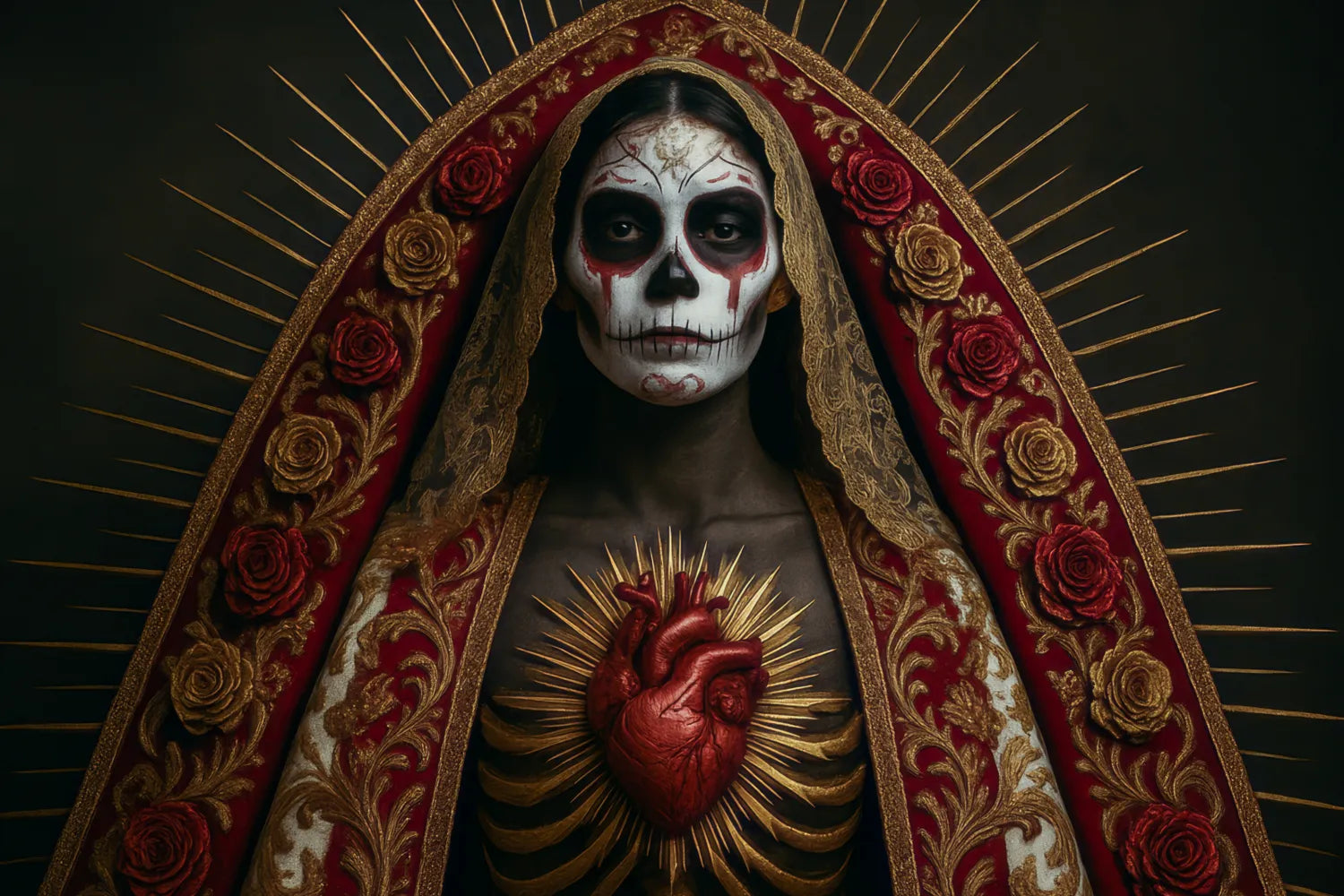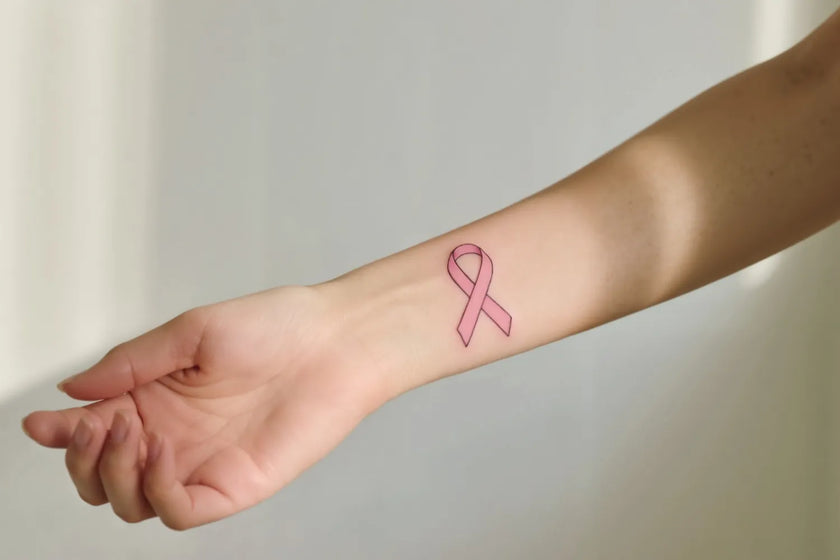Key Takeaways
- Santa Muerte tattoos carry deep cultural and spiritual meaning rooted in Mexican folk belief.
- Design elements like robe color, symbols, and placement are intentional and often tied to specific petitions or life experiences.
- Respect for the symbol is crucial, especially if you’re outside the culture. Perceptions vary widely, from reverence to suspicion, depending on context.
Walk into certain tattoo shops in Mexico City, Oaxaca, or along the Texas border, and you might see her. She's a robed skeletal figure, sometimes holding a globe, sometimes a scythe, sometimes both.
Her face is a grinning skull, framed by a halo of roses, candles, or rays of light. She’s not a comic book villain or a movie character. She's Santa Muerte, translation Saint Death, a folk saint whose image carries deep meaning and cultural importance.
In Mexican culture, Santa Muerte is a religious symbol, a spiritual figure, and for many, a source of protection, guidance, and justice when other saints have failed them. A tattoo of Santa Muerte signifies that you’re carrying a declaration of belief.
Before you decide to bring her into your skin, let’s break down exactly what Santa Muerte represents, where she comes from, and what your tattoo might say about you to those who understand her story.
Who Is Santa Muerte?
Santa Muerte (literally “Holy Death”) is a folk saint venerated in Mexico and by Mexican and Latin American communities worldwide. She’s depicted as a female Grim Reaper with a skeletal face, long robe, and a scythe.
Unlike Catholic canonized saints, Santa Muerte is not recognized by the Vatican. In fact, the Catholic Church has publicly condemned her worship, calling it incompatible with Christian teachings. This hasn’t stopped her following from growing among Mexican Catholics who incorporate folklore practices with their religion.
Santa Muerte is associated with protection from physical harm, enemies, and bad luck. She can also be used to represent justice, especially when people feel as though the traditional justice system has failed them or their family.
The Cultural Roots of Santa Muerte
Santa Muerte’s image blends influences from Aztec death deities, like Mictecacihuatl, the Lady of the Underworld, who presided over festivals honoring the dead and Spanish Catholicism, which introduced saint veneration and the imagery of the Grim Reaper. She’s like a female equivalent of the ancient Mayan Ah Puch, but with a slightly more optimistic connotation.
Her general presentation with roses and a scythe stems from folk traditions, including spiritual practices outside official Church authority. Her modern popularity surged in the late 20th century, especially among people marginalized by mainstream institutions. Working-class communities, and people seeking justice outside formal legal systems turned to worshipping Santa Muerte.
In Mexico, Santa Muerte isn’t just a symbol for the criminal underworld (though the media often pushes that stereotype). She’s also the saint of market vendors, taxi drivers, street workers, single mothers, and everyday people who feel overlooked by other saints. She's kind of like a vigilante for those who feel like they've been treated as misfits.
Some people turn to Santa Muerte for physical, emotional, and spiritual healing after they've lost a loved one. She can be used to wish safe passage for travelers, but the passage is usually dedicated to the souls of the dead moving on to the afterlife.
Santa Muerte is also used as a reminder that no matter your wealth or status, death comes for all. She's a way to make peace with death and to cease fear of your mortality. The idea is that when it's your time to go, Santa Muerte will be with you.
Why People Get Santa Muerte Tattoos
A Santa Muerte tattoo can carry multiple meanings, depending on the wearer’s beliefs and life experiences. In the tattoo world, she’s both sacred and personal.
Protection
Many wear her image like armor. The belief is that Santa Muerte watches over her devotees, keeping harm at bay. A tattoo is like a permanent protection talisman that will protect you all the way to the afterlife.
Reminder of Mortality
Santa Muerte embodies the idea that death is inevitable and impartial. Wearing her is a constant reminder to live fully and without fear.
Justice and Retribution
For some, she’s a symbol of balance. Santa Muerte is the cosmic equalizer who ensures that everyone, regardless of power, meets the same fate. This can resonate with those who have experienced injustice.
Identity and Heritage
For people of Mexican descent, a Santa Muerte tattoo can connect them to their cultural roots, folk traditions, and a lineage of spiritual resilience.
Most tattoos are fair game based on aesthetics alone, but you’ll want to be a little more careful when it comes to tattoos that represent the spiritual or religious beliefs of another culture. Santa Muerte looks cool, but you need to remember that her symbolism is heavily important to many people.
Common Santa Muerte Tattoo Designs and Symbolism
Santa Muerte tattoos vary widely, but some elements show up often, each with its own symbolism. Some devotees stay very traditional in their art style, but you'll occasionally see very unique artistic renditions of her figure.
The Scythe
The scythe represents the cutting of the thread of life, but also clearing obstacles. In tattoos, it’s often depicted mid-swing or resting against her shoulder.
The Globe
The globe symbolizes her dominion over the world and her ability to influence events anywhere. It’s a common choice for people who travel frequently or live far from home.
The Scales
Sometimes, she’s shown holding scales or standing beside them, representing justice and fairness. This version often resonates with those who have experienced legal struggles or want karmic balance.
Colors of the Robe
In Santa Muerte devotion, robe colors carry specific meanings.
- White: Purity, protection, and peace.
- Red: Love, passion, and emotional matters.
- Black: Protection from negative energy, strength, and resilience.
- Gold: Prosperity and success.
- Green: Justice and legal matters.
It's not unusual to see Santa Muerte depicted with a multicolored robe or layered robes that showcase different colors.
Candles, Flowers, and Religious Symbols
Candles signify prayers and petitions. Roses, especially red and white, connect to love, remembrance, and devotion. Although Santa Muerte took on a life of its own in spiritual folklore, the roots are similar to Catholicism.
Some people may blend more heavy-handed Catholic imagery, like rosaries, into their tattoos. There may be some overlap between the scenery surrounding Santa Muerte tattoos and Christian tattoos because most Santa Muerte believers would also consider themselves followers of Christ.
FAQs
Is it disrespectful to get a Santa Muerte tattoo if I’m not Mexican?
It depends on your intent and understanding. Research thoroughly, approach with respect, and consider cultural perceptions.
Does the color of Santa Muerte’s robe matter in a tattoo?
Yes. Devotees believe each color carries a specific meaning, so choose intentionally.
Will a Santa Muerte tattoo get me judged in Mexico?
Possibly. Some see her as protective, others as controversial. Context matters.
The Bottom Line on Santa Muerte Tattoos
A Santa Muerte tattoo is a statement of commitment and belief. It’s a way to carry a spiritual protector, a cultural connection, or a philosophical reminder of life’s fragility with you forever.
If you’re thinking about getting her tattooed, take the time to learn her history, understand her meanings, and work with an artist who respects the weight of the design. If you decide to permanently dedicate space on your body to the Saint of Death, you can trust the contents of the HUSH tattoo aftercare kit to keep her beautiful eternally.
Sources:
Santa Muerte: Saint of the Dispossessed, Enemy of Church and State | Hemispheric Institute
The 23 Most Important Aztec Gods and Goddesses | History Cooperative
Santa Muerte: Dangerous superstition or empowering guardian? | U.S. Catholic




